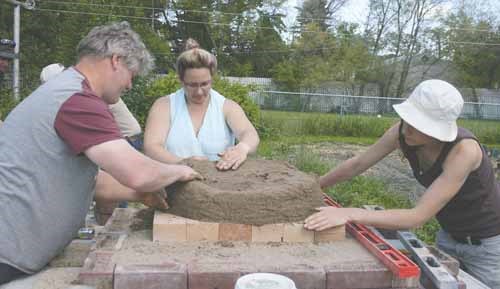A Yorkton couple spent Friday hosting a workshop teaching how to create a cob oven, and in the process now have an oven in their backyard.
For Rob and Stacey Tress the oven is part of their desire to re-connect with a simpler past, and to make do with what is at hand, a philosophy which includes collecting natural foods locally, and growing a large chemical free garden.
In the case of the cob oven, it was built in the couple's backyard during a workshop taught by Dirt Craft Natural Building, a small business based in Calgary that teaches natural building skills throughout Canada..
Cob, or cobb is a building material consisting of clay, sand, straw, water, and earth, similar to adobe. Cob is fireproof so it can be made into ovens.
As an oven cob material holds the heat well, explained Rob. He said a fire is actually built inside the oven, and then the ash and embers removed in order to place whatever is being baked. The actual cooking coming from the heat stored within the cob walls.
"It fires over a period of time, usually 12 hours," he said. " You can use it for a range of things."
Rob said since the oven cools over that period, cooking is actually done over the period of firing. As an example, when at its hottest the oven works ideally for pizza. As it cools bread bakes well, meat roasts cook, and at the end the oven can be used to dehydrate herbs.
A temperature gauge can be added to the oven in order to match the required heat level with what is being cooked.
"It's a most efficient bread oven," noted Rob.
Stacey said the oven has advantages in other ways than how it cooks, particularly in the summer when using an outdoor oven means not having to turn on the oven in the house.
"It doesn't generate heat inside the house. It's more energy efficient. You don't have to run the air conditioner," she said.
Building the oven was not hugely expensive either.
"You make it from local material," said Rob. He said the straw came from his parent's farm, and he simply dug down a foot or two in his garden to find the clay.
In making the mixture oxen were traditionally used to trod the mixture together, although Friday it was human foot power which did the dirty work at the local workshop.
Rob explained the ovens are actually built in layers.
Sand is used to make the interior of the oven, which is covered with newspaper, and then the cob mixture packed over the sand by hand. The sand will be removed through the door after the oven is complete, creating the area for the fire and baking.
As layers are added the walls become nine to 12-inches thick.
"The thick walls are why it holds the heat for so long," said Rob.
The walls are also why it will take two or three weeks for the oven to completely dry before it can be used.
The oven also weighs hundreds of pounds, so requires a strong foundation, noted Rob. In their case the oven sits on four concrete pillars set into the ground.
While the oven has a functional aspect, it can also become an object of art.
The material can be used to create artistic, sculptural forms which can be incorporated into the oven. Such efforts can include nearby clay seating, or actual sculptural aspects to the oven structure.
"There's an element of artistic expression," said Stacey. "It's really up to the imagination of the people making them."




